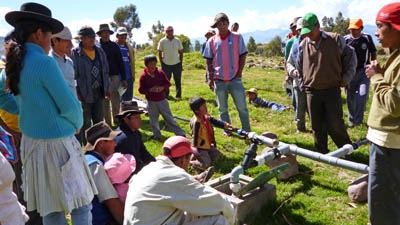Irrigation in Peru
A group of experts met in Lima to analyze the situation of irrigation in the country and to evaluate the results of the study The future of irrigation in Peru (s). The ultimate goal is to design policies that can benefit thousands of rural residents while at the same time safeguarding one of their most valuable resources: water. According to the study, Peru currently has nine major types of irrigation systems, which can grouped in three agro climatic zones in the country. Having a variety of systems hinders the implementation of a single solution to the country’s irrigation problems.
This diversity makes it necessary to develop flexible solutions that take local characteristics into account. The government and the WUOs in the field should work together to improve irrigation systems and control of the country’s water resources.
“The emphasis should be on withdrawing and distributing water resources. According to law, this is the responsibility of the water users’ organizations. These organizations need training so that they can assume full responsibility for water control,” says Jorge Zuñiga Morgan, executive director of the Ministry of Agriculture’s Irrigation Sub-sectoral Program.
The water experts gathered in Lima in early September recommended the following:
- Take advantage of the reform that the Ministry of Agriculture is implementing to strengthen its role in the sector and to fill institutional gaps with respect to the training and supervision of WUOs. This should be accompanied by a national irrigation and drainage strategy.
- Provide advice and technical assistance to address the real needs of these organizations and provide them with a legal framework that facilitates resource management.
- Establish a technical center for training in irrigation and drainage systems to serve all organizations involved, including the WUOs and the government.
- Develop projects to improve irrigation systems, financed by a national fund that promotes public-private co-financing.
Experiences in other countries
Other countries have implemented successful experiences in this area. In Chile, for example, the government has introduced several laws to stimulate private investment, which facilitates the growth and modernization of the water resource sector. Over the past 13 years, private investments have increased from US$ 30 million to US$ 82 million.
In Argentina, the 1994 Constitution transferred water control to the provinces. This enabled provincial and municipal governments to administer natural resources such as water.
In that country, Mendoza Province has made noteworthy advances in irrigation. Irrigation services and much of the investment in infrastructure are covered by user fees, without the need for support from the provincial government. However, much of the initial financing to achieve the sustainability of these projects was made with support from international cooperation agencies.
“The tariff system should be simple and in the hands of users. They should administer the part that corresponds to them and verify that the system works. This allows for increased transparency and flexibility in the distribution of water,” says Juan Pablo Yapura, cabinet chief and coordinator of Argentina’s 2020 Water Plan.

